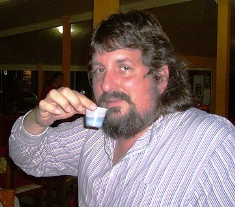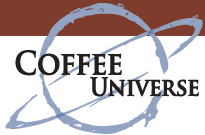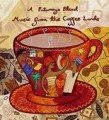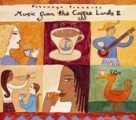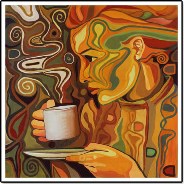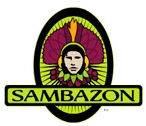What
is the
geography of coffee?
This is the confluence of two of my great passions: learning
about the
world (geography) and enjoying a hot, bitter beverage
(coffee)! In my
environmental geography course, I usually spend at
least two class
sessions discussing the relationship between the beverage in
my cup and
the bean on the bush. For me, coffee is an excellent
jumping-off point
for understanding
natural resource conservation and exploitation, equity in
international
trade, the geographic displacement of environmental
problems, and
global patterns of colonization (described succinctly in
ICO's Story
of Coffee) and post-colonial economic
relationships. This page is my humble contribution to the
discussion.
This handy map is found on
a wall in the Coffee Museum in downtown
Matagalpa,
Nicaragua.
The beans are shown in the tropical locations of
former colonies; the
ships represent the long-standing patterns of
trade; and indigenous
people represent the connection of many coffeeland
people to their
ancestral roots. |
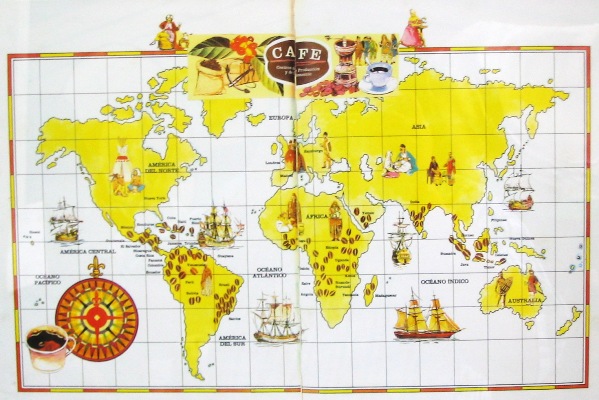
|
The
geographic
distribution of coffee production is of more
than
academic interest. It so happens that coffee is
deeply intertwined with
critical environmental concerns, including
biodiversity and climate
change. For example, Conservation International
has found that about
half of the world's biological hotspots are in
coffee-growing areas.
(And on the map below, I can see at least one
new coffee-growing area
that they did not include). This means that the
coffee business is in a
position to make a real difference in the
protection of endangered
habitat.
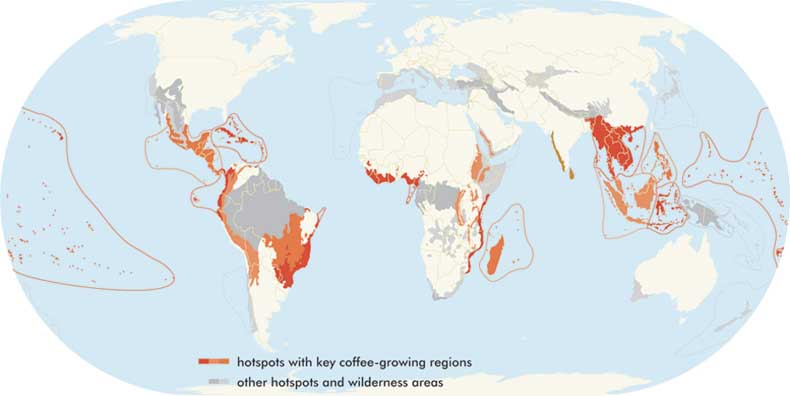
Because the
coffee
plant is very sensitive to climate, the prospect
of
climate change concerns coffee farmers greatly.
The United Nations
Environment Program cites the 1989 study
illustrated below as an
example of this sensitivity. Researchers found
that even the relatively
adaptable robusta variety
would be very vulnerable to warming. The
higher-quality arabica may be even
more
vulnerable. Even where coffee could survive
climate changes, the local
characteristics that can define a specialty
coffee are quite likely to
be lost, creating significant financial risks
for growers of the best
coffees. The coffee
growing
and
climate change report at Coffee
& Conservation
provides context and further information.
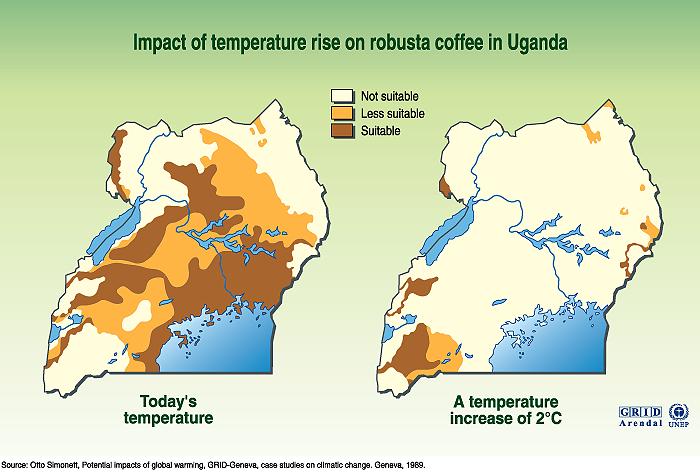
|
Vanderbilt
ICS
Vanderbilt
University
has
a
long-standing reputation as a leader in
Brazilian studies, beginning in
the
1940s. It may be no surprise, then, that
Vanderbilt is home to the
Institute for Coffee Studies.
The institute has been
focused on research on the medical aspects of
coffee. Drawing on the impressive medical
infrastructure of the
university and the city of Nashville, that
tradition continues, but ICS
is now housed in Vanderbilt's Center for Latin
American and Iberian
Studies. The Institute's mission now includes
research on health,
research on social aspects of production and
consumption, and the
encouragement of economic development in
coffeelands.
In March
2008, I was
honored to join the institute as an affiliated
scholar.
|

|
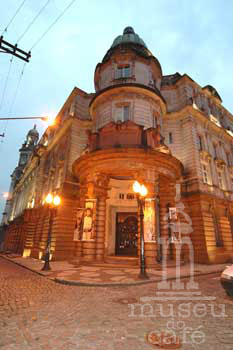
|
As
Frank Sinatra sings, They
Drink
an
Awful Lot of Coffee in Brazil. I know this
from
experience -- coffee seems to be offered in every
corner of the
country, usually in a tiny, plastic cup as shown
at the top of this
page. Brazil has been the leading exporter of
coffee for
many years, currently supplying about one-fourth
of the world supply.
In October 2008, I had the great pleasure of
visiting the coffeelands
of Minas Gerais, where conventional farms are just
beginning to move
toward specialty coffee. I also visited the key
exporting zone of
Santos, spending most of my time in the Museu do
Café. The museum is housed in an
opulent palace built in
1922 to
consolidate the operations of the coffee market. I
was particularly
impressed by an extensive exhibit about the
difficult experience of
Nippo-Brazilians, the thousands of migrants who
came from Japan to
Brazil to work in coffee as slavery was ending.
During this brief tour, I learned a lot about the
differences between
Brazilian and Central American coffee. In the
summer of 2010, I hope to
return both to Minas Gerais and to Santos as part
of a study tour that
will also include urban development in São
Paulo, Curitiba, and
Florianópolis.
|
Banco
do Café image courtesy of Ron Wise.
This image is an important motif in the Coffee
Museum.
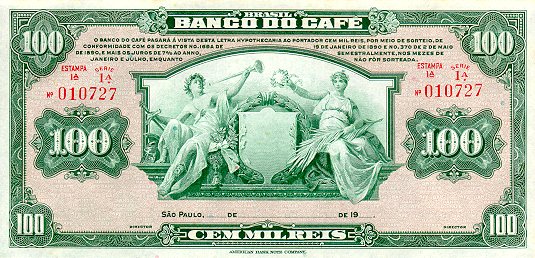
See images of coffee on the bank notes from
throughout the world on the collection
of
Café Bueno in Santo Domingo.
|
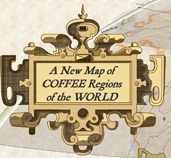
|
Get
coffee maps!
Researchers at
Artisan Maps have worked for over a year to create
a
coffee map of the world and four maps of coffee
regions. Learn about
the connections between flavor and geography from
this informative
series of Coffee Map Posters.
The US
Geological
Service EROS Data Center has created a GIS tool to
help buyers and sellers document certification
standards and find
specialty farms in various categories. Read about
the project in ArcNews.
|
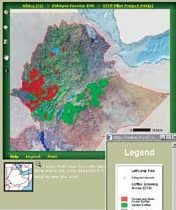
|
The International Coffee
Organization
is the main governing body in the coffee industry. Its web
site
includes an overview of the coffee crisis and a plethora of
statistics
about coffee trading.
For extensive background on the problems facing coffee
farmers, see the
September 1995 issue of
The New
Internationalist entitled Coffee:
Spilling
the Beans, which includes almost a dozen
articles on
the politics, economics, and geography of coffee.
Coffee and Conflict
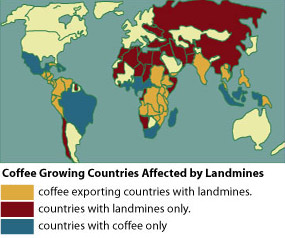
|
Coffee is grown
mainly in
the former colonial lands of the low latitudes. In
too many cases, the
post-colonial legacy includes inequality, uneven
development, and
violence. The Coffeeland
Landmine
Victims' Trust was established to help address one
particularly tragic
reminder of violence that can outlast any peace
treaty. In Nicaragua,
for example, the civil wars have ended, but the land
mines still lurk
in some coffee fields where they have been long
forgotten.
The Trust
works with
its own partners and with those already involved in
the coffee industry
to provide emergency and rehabilitation services to
people who are
seriously injured by mines.
Note: Although
the U.S. government
has provided some support for this rehabilitation
work, we are one of
the few countries that still refuses to stop using
mines and cluster
bombs, both of which can kill and maim people
years into the future.
|
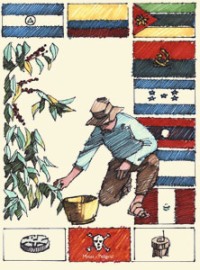 |
To learn about the history of the coffee break in the U.S.,
listen to
Susan Stamberg's Present
at the Creation report from the December 2, 2002
edition of
NPR's Morning Edition (this page includes several
related
links).
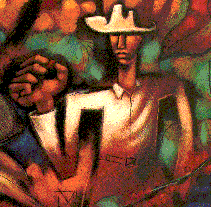 As with all of Nicaragua, the
coffee-growing North was a dangerous and tumultuous place at
the time
of the U.S.-funded contra war. Dreaming
Nicaragua: Morning Coffee and the Contra War is an
engaging and disturbing story that comingles coffee and
history. As with all of Nicaragua, the
coffee-growing North was a dangerous and tumultuous place at
the time
of the U.S.-funded contra war. Dreaming
Nicaragua: Morning Coffee and the Contra War is an
engaging and disturbing story that comingles coffee and
history.
I recently learned that the state of Rondonia
is now the sixth-largest producer of coffee in Brazil, and
the second
largest
producer of the conillon variety. A
Brazzil magazine article,
Fleeing the Cold
, describes how this has come about. More detail is provided
in Chapter
6 of Nigel Smith's
Amazonia - Resiliency and Dynamism of the Land and its
People.
My friends in Oxfam's Boston coffee campaign have alerted me
to a
couple of interesting studies on the Oxfam America web site:
The Specialty Coffee Association of America SCAA sets the industry's
standards
for growing, roasting and brewing. Members of the SCAA
include coffee
retailers, roasters, producers, exporters and importers,
as well as manufacturers of coffee equipment and related
products.
See the
coffee category
of DMOZ for more. I was once the editor!
Eat Up is a book
about
unusual cuisines, written by a Canadian food scientists who
travels the
world to study
the most unusual food and drink he can find. Civet coffee
from
Indonesia certainly
earned his attention. Listen to
Professor Marcone's interview on the NPR program Fresh Air to learn,
ahem, where
this coffee comes from.
 Coffee Kids is an
international,
non-profit organization established to improve the lives
of children and families who live in coffee-growing
communities around
the
world. Whenever I give public
lectures
about coffee, I serve the audience the best, fairest coffee
I can, and
I donate 100 percent of any honoraria I receive to Coffee
Kids. Coffee Kids is an
international,
non-profit organization established to improve the lives
of children and families who live in coffee-growing
communities around
the
world. Whenever I give public
lectures
about coffee, I serve the audience the best, fairest coffee
I can, and
I donate 100 percent of any honoraria I receive to Coffee
Kids.
|
 My coffee
obsession began when I started to understand how the fair-trade
movement was helping to improve the lives of farm
families who work
very hard to produce fine coffees and who
earn very
little for their efforts. I have been fortunate enough
to take students
to the
coffeelands
of Nicaragua twice and will return in 2009. I have also
now visited
coffeelands in Guatemala and will tour coffee production
in Brazil
before the end of this year. The coffee
index page is now the gateway to all of my coffee
endeavors, from the romantic and the divine to the
culinary and the commercial.
My coffee
obsession began when I started to understand how the fair-trade
movement was helping to improve the lives of farm
families who work
very hard to produce fine coffees and who
earn very
little for their efforts. I have been fortunate enough
to take students
to the
coffeelands
of Nicaragua twice and will return in 2009. I have also
now visited
coffeelands in Guatemala and will tour coffee production
in Brazil
before the end of this year. The coffee
index page is now the gateway to all of my coffee
endeavors, from the romantic and the divine to the
culinary and the commercial.